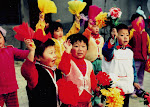Travel in the Middle Kingdom can seem intimidating because it's such a mysterious, alien culture with customs we aren't familiar with, foods we don't eat, and a language we can't speak or read. Many travelers find the combination too daunting so they sign up for packaged tours where you get a Westernized version of the country.
But independent travel is possible in China, especially if you've done your homework and have some idea of what to expect. That's where I can help you. If you have questions about traveling in China, especially Beijing, I can help you or, if not, tell you where you can find the help you need. One of the things I like to do is help people make sure their trips to China are a success. China is one of my favorite countries (good thing, because I lived there two years and have made about a dozen other trips there!) and it's important to me that people like China.
People email me questions frequently -- maybe I'll start an FAQ on my China travel website of the questions I get asked a lot. Sometimes people will send me several emails, such as one lady from Texas. We emailed frequently for more than a year after her initial question about independent travel versus a tour. She and her husband decided to travel independently. The following is an excerpt of the email I received from her when they got back:
" I wanted to let you know we had a wonderful, marvelous trip and experience in China. I am so grateful that you gave me the encouragement and confidence I needed to go by ourselves. I can’t remember how many people we talked to while we were there who told us “how brave” we were for being on our own (and people at home thought we were crazy), but we have never felt safer on any of our travels, even in our own neighborhood at night! And the lack of being able to verbally communicate wasn’t the barrier I expected. Travel around the country was no problem at all. "Emails like this really make me feel good.
So if you have questions about travel in China, email me and I'll do my best to answer them.
Give a Cheryl's Guide for Christmas!
If you hurry, there's still time to order a Cheryl's Guide for the traveler on your Christmas list:
- Parents Guide to Beijing is filled with Beijing sights and attractions your kids will enjoy.
- DIY Beijing expands upon the information in Parents Guide but is geared to adults.
- Motorcycle Museums of the United Kingdom has information about all the museums that I could find in the United Kingdom that contain at least one motorcycle.






























